From the West Hartford Archives: Tree Pruning and South Main Street at Farmington Avenue

Audio By Carbonatix

Tree pruning on South Main Street, looking south from Farmington Avenue. Photo courtesy of Noah Webster House & West Hartford Historical Society
Historian Jeff Murray takes a look into West Hartford’s past to uncover some surprising information, stir up some memories, or reflect on how much life has changed – or hasn’t changed at all. Enjoy this week’s ‘From West Hartford’s Archives’ …
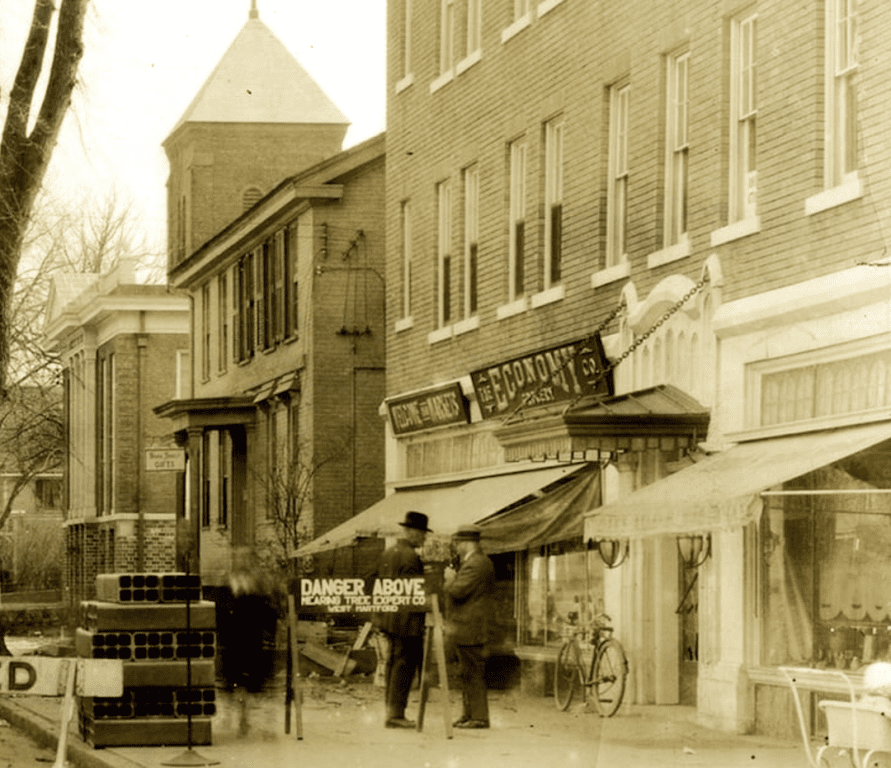
An enlarged portion showing the buildings on the west side of South Main Street. Photo courtesy of Noah Webster House & West Hartford Historical Society
By Jeff Murray
This is a photograph of South Main Street looking south from Farmington Avenue, showing trees being cut or pruned. A sign on the right advertises the local Nearing Tree Expert Company, so this may have been taken in April 1928 when it was reported that the company was cutting down trees lining both sides of the road to the end of the green.
The only building standing today is the one at the southwest corner. Before this modern block was constructed in 1922, it was the site of the old West Hartford Post Office in the 1800s, owned and occupied by Leonard Buckland. A shoemaker by trade, Buckland opened a general store and built an addition to the rear.
Three generations of Bucklands conducted the office and store (to Leonard’s son Merton and then to his son Frank, both jobs inherited on their fathers’ deaths). In 1899, Allen B. Judd became the first person to establish a local drug store in town, renting a space in the Buckland store a year later, just before his marriage. Judd put up an exhibition at the store out front with notable mementos that were of interest to passersby (items from his mining expedition to Alaska or newly crushed rock from the town quarry). He held a word contest for school kids in 1903 and the store was the go-to place to buy tickets for numerous social events, like Glee Club concerts or plays.
The store was also treated sometimes like the old version of our modern urgent care – just a few weeks after he opened in 1900, a Swedish employee of the Vine Hill Farm slashed his arm on a piece of glass and went straight to Judd’s store, unable to find a regular doctor.
The business grew over time and was able to add new things, like a soda fountain just before Christmas 1907. A few years later, he installed a new carbonator in his basement, powered by an electric motor. The store also had a public telephone, but after a petition in 1912, the telephone company built a “private” booth across the street for business purposes – unsurprisingly, the public telephone at the store was not private enough!
Employee turnover was high, as it was a good spot for high school or college students on break. One of his employees during this time was 23-year-old Henry Kottenhoff, who later went into partnership with Judd and then went solo down the street on Farmington Avenue until his retirement in 1958. During World War I, Judd’s drugstore sold Red Cross stamps, installed a gas tank for supplying automobiles, and he officially incorporated his business.

Judd’s Drug Store at the southwest corner. Photo courtesy of Noah Webster House & West Hartford Historical Society
As the third-generation Buckland who owned the property gradually stepped away from post office duties and went into business for himself building homes in the Center and running a movie theater in Bristol and Montreal, interest in developing the property as a business corner by outside parties rose. In the summer of 1916, Buckland sold it all to Clayton A. Parker, a real estate developer in New Britain.
At the time of purchase, the corner contained the Judd drug store, the post office, a tenement in the back occupied by the Buckland family, the Sauer barber shop, Alexander Keeney’s undertaking rooms, and a second-floor tenement that had been rented out. Parker only built an expanded post office, store, and tenement on Farmington Ave to the west of the old building and then Judd bought the corner back.
In 1919, he sold the property to Dr. Abraham Fischer (who then sold it to another party, Gordon & Wagman, in 1921). Despite the constant question of “who owns the corner this week?”, it was this syndicate that ultimately tore down the old building and built the current brick block. When it opened, it contained Judd’s drug store, the post office, the Economy Grocery, the SunCourt Meat Market, dentists’ and doctors’ offices, and apartments. The Hartford Courant reported: “Many of the older residents of West Hartford regret the passing of the old building which has stood for more than 100 years.”
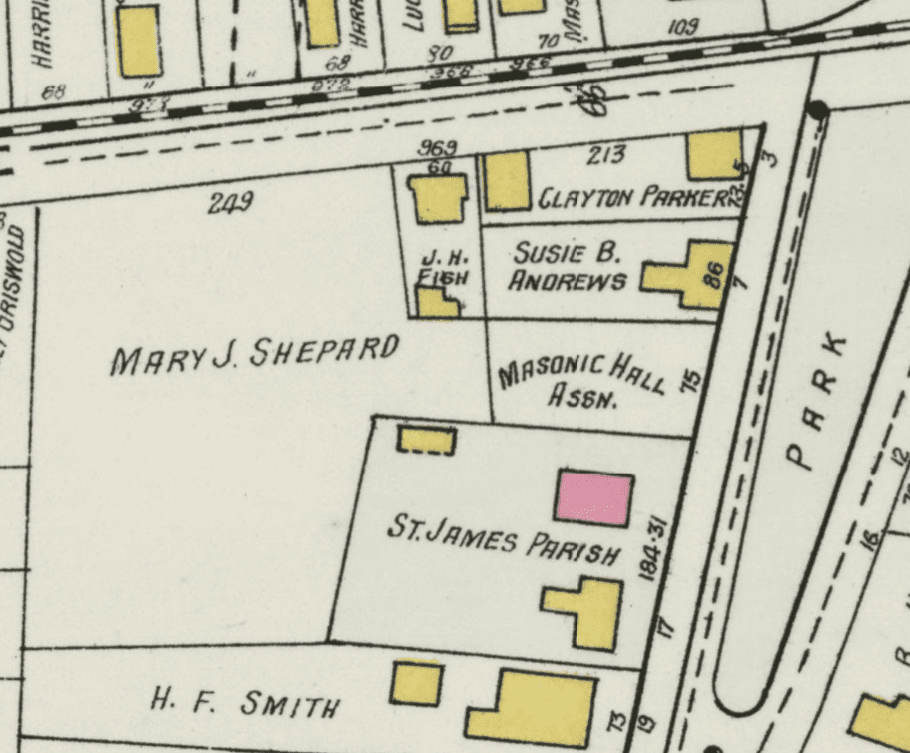
Map of the southwest corner in 1917.
South of the corner property was land owned by Mary J. Griswold Shepard. From the prominent Griswold family, she rented out the house (known as 7/9 South Main Street) to two dozen or more people over the years. Some who would later build houses in the Center for themselves, like Henry Corning or the town physician Dr. Ralph W. E. Alcott, rented it while construction was ongoing.
A store fronting on Farmington Avenue, built in the 1890s, was known as the Shepard building and hosted Henry Selden’s ice cream shop, a meat market, a tinsmith, a grain business, and a variety of other enterprises. In 1912, Shepard sold the brick house on South Main Street to the Andrews family, who intended to gather other businessmen in the area and purchase the whole corner for a large business block – unfortunately, this project fell through, but the Andrews family retained ownership of the brick house through the construction of the current building on the site in the 1930s (and it is still in their possession today).
Further south at 11 South Main Street, where the Masonic Temple used to be, the lot was also owned by Shepard for many years, but she intended for it to be used for something else. After the local chapter of the Daughters of the American Revolution formed in 1906, the organization immediately set out on a yearslong fundraising effort to build a Noah Webster library building. The free public library had originally been in the Congregational Church and it was felt that it needed its own building as it grew. The D.A.R. held a number of fairs and socials to raise the $25,000 needed for such a site. It is impossible to overstate just how important this effort was – it impacted almost everyone in town in some way and was for a great cause, but it also heightened certain local tensions between prominent families, mainly regarding where the library would be built.
In December 1909, Mary Shepard and her brother Henry Griswold offered to donate the lot at 11 South Main Street to the D.A.R. for the library. It was initially accepted, but after the fundraising was completed in 1913 and building was set to begin, some opposition was made that the lot was too small. The disagreement on the final site quickly snowballed into chaos.
Two weeks after the assassination of Archduke Franz Ferdinand in June 1914, which set off the events leading to the eruption of World War I in Europe, the Hartford Courant’s front page news story was about a different war. The headline: “WEST HARTFORD IN LIBRARY WRANGLE” and “D.A.R. SPLIT INTO WARRING FACTIONS.” Mary Shepard had changed her mind and wanted the land back, the town planning board wanted a larger lot, the D.A.R. was accused of stuffing ballot boxes and calling meetings at irregular times to manipulate who was voting on where the library would go.
“Friendships have been shattered in verbal conflicts,” reported the Courant.
All work in the organization was stopped for several months and negotiations for an “armistice” took over. After nearly a year, the D.A.R. voted to instead go with a lot at North Main Street and Brace Road and give the land on South Main Street back to Shepard. The building was finished in 1917 and the library was hosted there until 1937 when a new library was built. It still stands at the corner of Brace Road, facing North Main Street. Shepard, upon receiving back the land, sold it almost immediately to the Masonic Hall Association for a temple. When the lodge’s current space wasn’t sufficient anymore in 1923, they built on this lot the temple that most people remember. It was dedicated in 1927. In 2013, the property was sold and demolished, replaced by a four-story mixed-use apartment building.

The building project at 11 South Main will begin with the demolition of the Masonic Temple. Photo credit: Ronni Newton (we-ha.com file photo, July 2014)
Finally, the St. James Episcopal Church can be seen in the background. It was built in 1853 to accommodate public services that had originally been held in the Quaker Meeting House on South Quaker Lane. The Huntington and Beach families held important positions within the church for decades (and they were its most significant financial benefactors). In 1948, the rector at the time appointed a committee to study the needs of the parish; this committee recommended that a site be procured for a new church.
In the spring of 1953, the South Main Street church and rectory were sold and torn down to make way for eight stores. In 1961, ground was broken at 1018 Farmington Avenue for the new church, which connected with the previously built Walden Street parish house.
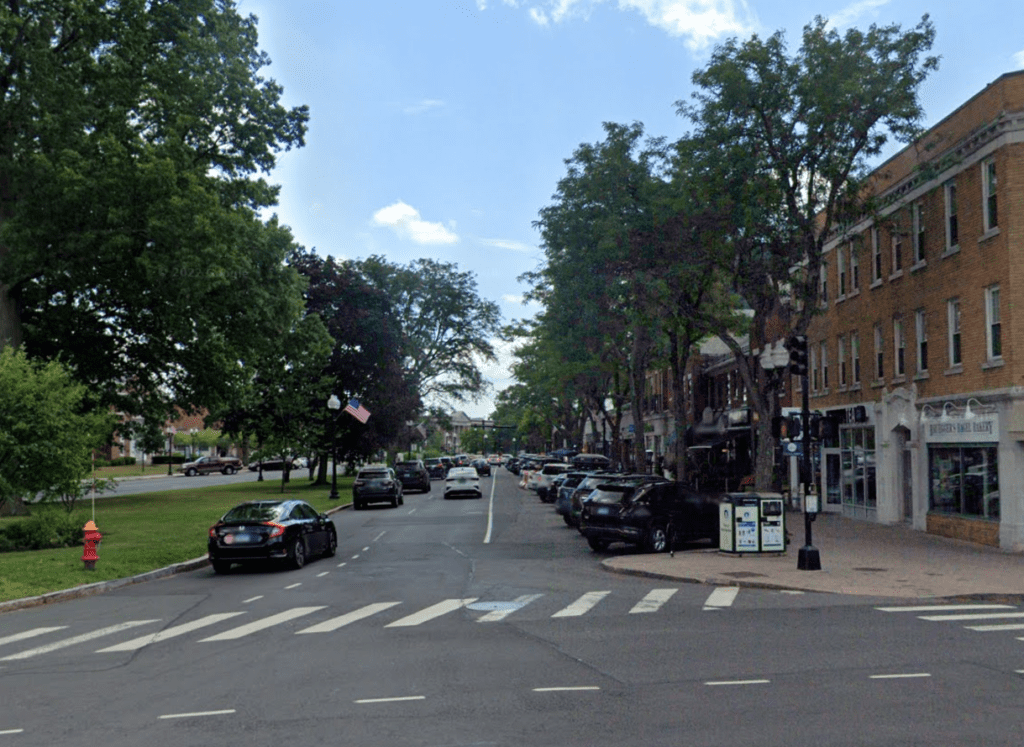
South Main Street, looking south from Farmington Avenue. Google Street View
Jeff Murray was born and raised in West Hartford and has been involved with the Noah Webster House & West Hartford Historical Society since 2011 when he was a high school student and won the Meyer Prize for his essay on local history. Jeff routinely volunteers as local history researcher uncovering information for numerous museum programs such as the West Hartford House Tour and West Hartford Hauntings. Jeff works as a data analyst at Pratt & Whitney.
Like what you see here? Click here to subscribe to We-Ha’s newsletter so you’ll always be in the know about what’s happening in West Hartford! Click the blue button below to become a supporter of We-Ha.com and our efforts to continue producing quality journalism.


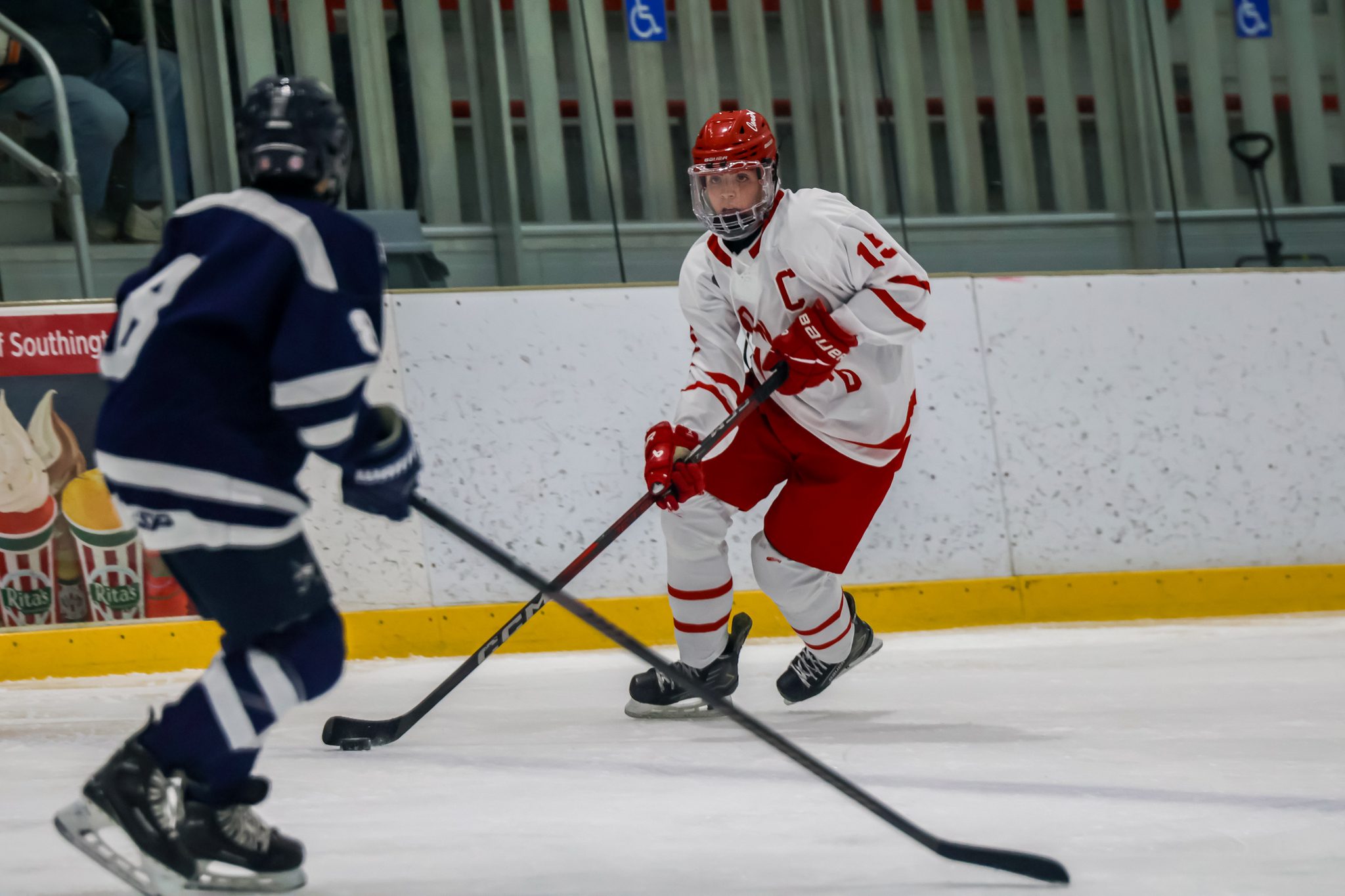
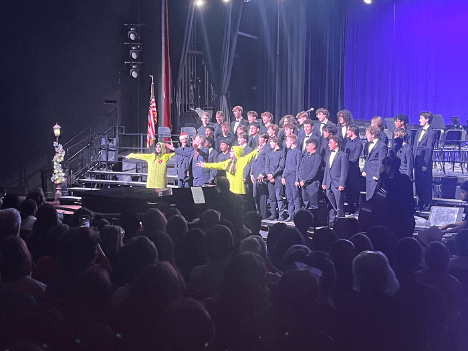
Those trees look a lot like elms. Dutch elm disease was first discovered in this country in the 1920’s. I wonder if these were among the first casualties in the U.S.